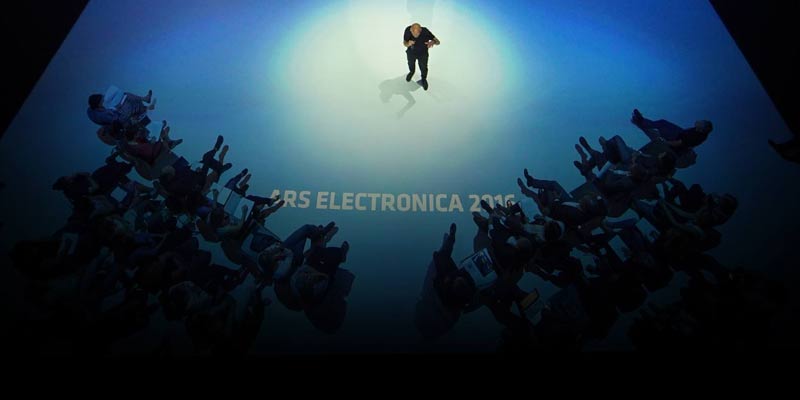Year-end financial statements confirm
Ars Electronica Had a Great Year Financially Too
(Linz, February 22, 2016) Ars Electronica Linz GmbH’s 2015 gross revenues came in at €14.6 million, a €1.5 million (11.5%) increase over the prior year, and topped by far the previous record in the corporation’s 20-year history.Chiefly responsible for this all-time high were the organization’s for-profit activities, and especially the revenues generated by Ars Electronica Solutions as well as projects commissioned by the Ars Electronica Futurelab’s impressive array of clients. These operating profits, in turn, not only contributed to maintaining Ars Electronica’s other divisions; they substantially fostered performance growth on the part of the Museum, the Festival and the Prix. The 2015 bottom line for Ars Electronica Linz GmbH’s results of ordinary operations was once again positive. “The just-completed final accounting for 2015 underscores the fact that this organization’s financial condition is outstanding and it is achieving optimal results with its existing resources,” was the highly upbeat summary by Gerfried Stocker and Diethard Schwarzmair, managing directors of Ars Electronica Linz GmbH.
Significant Growth in the For-Profit Divisions
Commissioned R&D, interactive installations and trade show booths, presentations, exhibitions and even complete museums—Ars Electronica Linz GmbH’s for-profit operations are highly diverse and very much in demand by such major corporations as SAP, Daimler, Intel, BASF and Primetals Technologies. Leading the way is Ars Electronica Solutions, the shooting star headquartered in Linz’s landmark Tabakfabrik facility. In 2015, the division’s staff carried out 65 projects in eight countries to generate revenues of €3.6 million, a €921,000 (34.9%) increase over the previous year.
It was another busy year for the Ars Electronica Futurelab too: 50 projects in eight countries brought in total revenues of €2.8 million. Particularly noteworthy are the Spaxels [Space Pixels] project’s spectacular unmanned aerial vehicle flights. The unit recently made international headlines with a 100-drone world-record performance commissioned by Intel. In 2015, the Spaxels really took off—the show design reached lofty new heights and the business concept broke out to the next level of success.In the year just concluded, Ars Electronica EXPORT staged 10 international exhibitions in nine countries, more than double the previous year’s volume.
Profits from Projects Expand Latitude for Creativity
In 2015, Ars Electronica’s for-profit operations yielded net income of over €700,000, which comes out to a gross margin of 10%.
“With public subsidies in increasingly short supply, the income generated by our for-profit divisions makes an important contribution to financing our not-for-profit, public-service activities,” noted CFO Diethard Schwarzmair. “This makes it possible to maintain and even expand the programs we produce under the aegis of the Museum, the Festival and the Prix.”
High Self-financing Quotient Attained by the Museum and Festival
As documented by the above-cited financials, Ars Electronica’s public-service divisions as well are characterized by a high level of economic efficiency. This is reflected by the solid self-financing quotient achieved by the Museum and the Festival. An excellent example is provided by the new Deep Space 8K. On the subject of the largest single investment Ars Electronica has made since the reconfigured Center opened in 2009, Diethard Schwarzmair stated: “In addition to the €500,000 we received from the City of Linz, we were able to put up €700,000 of our own funds to enable the Futurelab to develop a must-see facility that’s without peer worldwide: Deep Space featuring 8K resolution.”
And speaking of the Ars Electronica Center: the Museum of the Future attracted 171,808 visitors in 2015, an 8.4% increase over the previous year. Admission ticket sales rose to €511,000. Healthy growth was also served up by the AEC’s in-house event service, where revenues increased by 9.2% to €289,000.
Benefits-in-kind valued at €2 million provided by 430 partners and sponsors in early September 2015 laid the groundwork for POST CITY at which 482 individual events made up the largest and most diverse festival ever staged in Ars Electronica’s history.
Once again, the showcase of excellence in media art presented at the Festival featured the best works selected from among 2,900 submissions for prize consideration to the 2015 Prix Ars Electronica. Artists from 75 countries vied for honors including the coveted Golden Nica statuettes, thereby underscoring the outstanding reputation the Prix Ars Electronica enjoys in the media art scene worldwide.
“And we’re not letting up in 2016.”
Diethard Schwarzmair and Gerfried Stocker concluded their presentation by sketching the agenda for the coming year: “In 2016, we want to further expand our project business, stage more high-profile Spaxels flight shows, successfully carry out the STARTS competition launched by the European Commission, set up an Education_Lab as an umbrella organization for all our current and future educational offerings, and—by no means least of all—we want to go forward with our international activities while continuing to strengthen Ars Electronica’s regional presence and involvement.”
http://www.flickr.com/photos/arselectronica/24204732526/Drone 100 / Fotocredit: Intel Corporation / Printversion / Album

